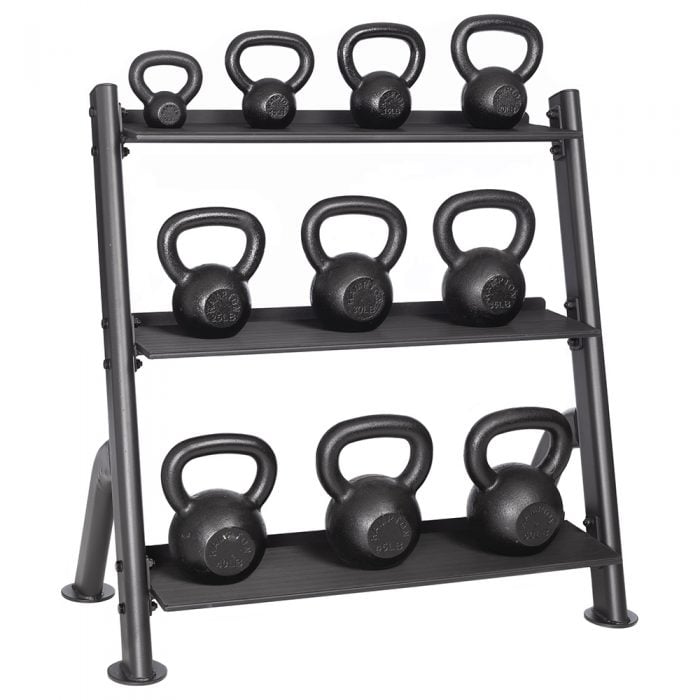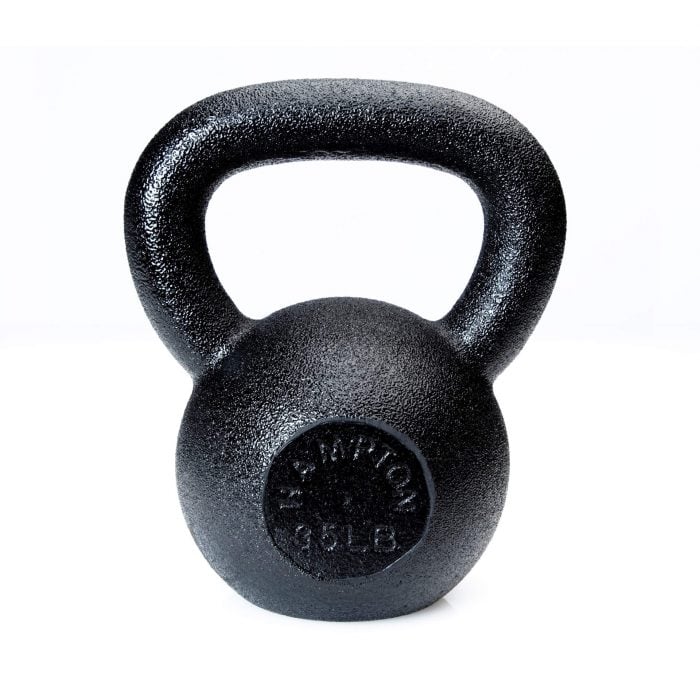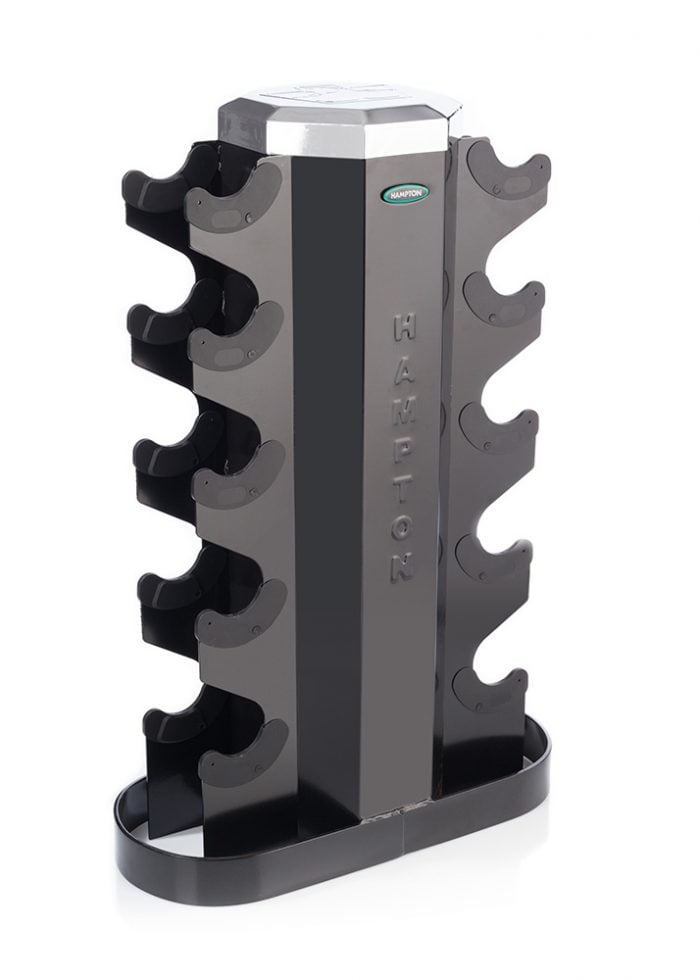Overview of Kettlebell Benefits
Kettlebells have become a staple in gyms around the world for a good reason. Unlike barbells and dumbbells, kettlebells are beneficial in weight training because they force you to contribute work between both sides of your body. They use all your stabilizer muscles to control the movement or swings of the kettlebell.
Kettlebells are a great weight training piece of equipment, but can also allow you to fit in a cardio workout through explosive kettlebell moves repeated at a pace that gets your heart rate up and burns calories just as a jog would. Doing a kettlebell circuit is an efficient way to get in a cardio AND weight training workout at the same time. You are basically using all of your muscle groups to control the motion of the weight and maintain your balance as you push through your workout.
Kettlebells are a great way to gain core strength without having to do a ton of planks or sit-ups to get the abs you want. Plus, kettlebells require full-body coordination: you can’t just coast through a kettlebell workout! You need to be fully present so that you don’t lose control of the weight or lose your balance.
Another great benefit of kettlebells is that they take up very little space, can go with you in your car to an outdoor park, beach, or field, and allow you to use one piece of equipment in different ways to get a full body workout.
Selecting the Right Kettlebell Weight
Deciding what kettlebell weight you should use depends on the type of exercise you are doing. If you are going to be using many joints at once it is OK to go heavier. If it’s a one-motion, one body part exercise, starting off slow with a lighter kettlebell size is better.
For a beginner who does not do a lot of weight lifting, start at a beginner’s weight size. For women, around 10 LB- 15 LB, and for men, between 20 LB and 30 LB. If you have been lifting for a while and have some solid experience, then we suggest that women begin with a 25 LB weight and men with a 45 LB.
Fundamental Kettlebell Movements
Kettlebell exercises rely on a few basic movements. Once you’re comfortable using your bells, you can do a whole bunch of exercises with them, including variations of squats, deadlifts, shoulder presses, rows, and presses. Depending on which exercises you choose, you can work your entire body using a kettlebell or two. And we’re here to help you get started: Take a look at some of the exercises below so you can get building your own kettlebell workout!
Recommended products
-
Traditional “Old School” Kettlebell Packs
$1,147.00 – $2,605.00 -
Hampton Outdoor Kettlebell – Urethane Coated
$52.00 – $286.00 -
2-Sided Vertical Rack | 5 Pairs
$309.00
Pressing Techniques
To get a well-rounded workout, doing some kettlebell presses is a great way to up your chest muscle game. Presses will work your pecs as well as your triceps.
- Lie on your back with your knees bent and feet flat on the floor. Hold a kettlebell in each hand by the handle with your palms facing in and your elbows on the floor bent at less than 90 degrees.
- Press the weights toward the ceiling, straightening your elbows completely and keeping your palms facing in.
- Slowly bend your elbows and lower them back down to the floor.
- Repeat for 10 reps.
Rowing Techniques
Kettlebell rows are a great way to work your arms and your core at the same time.
Kettlebell Bent-Over Row:
- Bend over at the waist and spread your legs to provide a strong base.
- Reach down with your right arm and grab the kettlebell.
- Pull the kettlebell up to your chest and then lower your arm back down.
- Repeat, then switch arms.
Hip Hinging Basics
The hip hinge motion is a fundamental exercise used for deadlift exercises. You should use the deadlift movement pattern whenever you pick up a heavy object off the floor. The deadlift is often mistaken for the squat movement but is very different. The squat is actually more knee-dominant. The hip hinge exercise involves pushing the hips backward while keeping the back flat.
With the hands hanging down towards the floor, the lower you wish the hands to go, the more you will have to push the hips backward. As the hips are pushed backward, the hamstrings attached to the bottom of the pelvis will be stretched, so those with tight hamstrings or limited hip mobility may find reaching the floor with their hands challenging. In contrast, the squat sits the hips back and down.
Squatting with Kettlebells
- Line yourself up with the kettlebell on the ground. How you get in and out of the exercise is an important part of staying injury-free. Start with the kettlebell right under your body, lining up the handle with your ankle bones so that you’re in a natural squatting position.
- Grab the kettlebell on top of the handle. Make sure you load your glutes instead of your back. Allow your hands to slide to the sides of the handle.
- Land with the bell’s handle at chin level. Don’t let it rest on your body because you want your back and core working to hold it up.
- Lower into your hips. With your toes pointing straight ahead.
- Hold for 2 to 3 seconds at the bottom. Then, press your feet into the ground to return to standing.
Rotational Movements
Rotational Pivot Swing:
- Leave some space between the feet while standing.
- Start with a double-arm swing.
- Guide the bell to the side and back from the top phase of the swing.
- Pivot and step out with one foot to prevent pressure on the knee.
- Brace the core.
- Make a V pattern with the kettlebell.
Beginner-Friendly Kettlebell Exercises
A deadlift involves lifting a weight to hip level. It’s a functional, practical movement, and in kettlebell training, it’s the first part of the swing. It’s easier than other types of deadlifts.
To start, place the kettlebell between your ankles, feet hip-width apart. Bend your knees slightly, keeping your hips elevated and your back flat. Grab the kettlebell handle with both hands, keep your arms straight, tighten your glutes and core, and stand up.
Goblet Squat: Technique and Benefits
The kettlebell goblet squat is one of the best ways to work your butt and quads. Adding a kettlebell increases the resistance your body has to work against to stand back up, challenging your muscles even more.
Goblet Squat
Goblet squats engage your entire body. They work your core, quads, and calves, as well as your glutes.
- Stand with your feet slightly wider than hip-width apart, toes slightly turned out, holding a kettlebell in both hands at your chest. You can hold it by the handles or by the bell.
- Engage your core and keep your chest lifted and back flat as you shift your weight into your heels, push your hips back, and bend your knees to lower into a squat.
- Drive through your heels to stand and squeeze your glutes at the top.
One-Arm Kettlebell Row: Execution Steps
The row is a classic upper-body exercise that works your lats and biceps.
- Stand with your feet hip-width apart, holding a kettlebell in each hand by the handle with your arms at your sides.
- With your core engaged, hinge forward at the hips, push your butt back, and bend your knees slightly so that your back is no lower than parallel to the floor.
- Do a row by pulling the weights up toward your chest, hugging your elbows close to your body, and squeezing your shoulder blades at the top of the movement.
- Pause here, squeezing your shoulder blades, and then slowly lower the weights by extending your arms toward the floor. That’s 1 rep.
Kettlebell One-Arm Press: Proper Form
The kettlebell overhead press works your shoulder muscles as well as your triceps. Your core is also firing here to keep your torso steady as you press the weight over your head.
- Stand with your feet about hip-width apart. Hold a kettlebell by the kettlebell handle in each hand at your shoulders with your palms facing in and your elbows bent. The bells should be racked on your shoulders. This is the starting position.
- Press the dumbbells overhead, rotating your hands so your palms face out, straightening your elbows completely. Make sure to keep your core engaged and hips tucked to avoid arching your lower back as you lift your arms.
- Slowly bend your elbows to lower the weight back down. Reverse the motion to the starting position.
Modified Kettlebell Swing for Beginners
The kettlebell swing targets your butt, legs, and lower back. Make sure you use a lighter kettlebell before adding too much weight. To perform a swing with proper form, you have to thrust your hips aggressively to get the kettlebell up.
- Stand with your feet hip-width apart and hold the kettlebell by the top of the handle with both hands with your arms straight in front of you.
- Bend your knees slightly, then hinge at your hips to swing the kettlebell between your legs.
- Stand up and thrust your hips forward explosively.
- As the weight falls, pull the weight back down, hinge at your hips, and move immediately into the next rep.
Shoulder and Hip Halo: Movement Guide
This move works your shoulders, abs, and chest. Keep your core tight and hold your torso stable as you rotate your arms and the weight. Tuck your pelvis under so that your back doesn’t arch. This ensures you’re working your abs and not straining your lower back.
- Start in a half-kneeling position with one foot and one knee on the floor, both knees bent.
- Lift the weight to eye level and slowly circle it around your head counterclockwise, making a halo shape. As you circle the weight around your head, maintain a tight core.
- Reverse the movement to return to the starting position.
- Then, repeat in the opposite direction.
Figure-8 Pass: Enhancing Coordination
- Set the kettlebell on the floor with the handle positioned diagonally, depending on which side you’ll start from. Grab only half of the kettlebell handle at the part that is furthest from you.
- Stand close to the kettlebell with feet roughly shoulder-width apart.
- Bend at the knees, hinge at the hips with the back flat and rounded, tighten your core, and then pick up the kettlebell.
- Swing the weight between your legs toward the opposite arm and grab the handle using the empty hand.
- Swing the bell around the outside of the leg, straighten your legs, and snap your hips forward. The arm should swing the kettlebell forward slightly.
- Swing the kettlebell back between the legs toward the opposite arm, grab it using the empty hand, and repeat this process.
Advanced Kettlebell Techniques
Full Kettlebell Swing: Step-by-Step Guide
Kettlebell swings are a staple for any kettlebell workout. They are simple yet effective and easy to begin with and adjust as your body gets stronger.
- Stand with feet slightly wider than shoulder-width apart. Hold the kettlebell in front of your body with both hands, arms straight.
- With a slight bend in your knees and a flat back, hinge at your hips and swing the kettlebell back through your legs. Use that momentum to stand and swing the kettlebell out in front of your body up to shoulder height.
- Thrust your hips forward, and engage your glutes and core as you stand up straight. When the kettlebell hits shoulder height, your knees should be straight and your glutes contracted in a full hip extension.
- Allow the kettlebell to swing back down through your legs while hinging at the hips.
Clean and Press: Building Strength
You’ll also hit your triceps in this move while working your pecs.
- Lie on your back with your knees bent and feet flat on the floor. Hold a kettlebell in each hand by the handle with a neutral grip- palms facing inward. Your elbows must be bent at less than 90 degrees on the floor.
- Press the weights toward the ceiling, straightening your elbows completely and keeping your palms facing in.
- Slowly bend your elbows and lower them back down to the floor.
Renegade Row: Core and Arm Strengthening
The single-arm kettlebell row works your back muscles and your biceps. Plus, because it’s a unilateral move, your core will also need to fire to keep you stable. Single kettlebell rows are a lot of work but have a big payoff!
- Stand with your feet hip-width apart, holding a kettlebell by the handle in your right hand with your arm at your side, palm facing towards your body. Step forward about two feet with your left foot, and rest your left hand on your left quad.
- With your core engaged, hinge forward at the hips, push your butt back, and bend your left knee, don’t round your shoulders. Your hip mobility and hamstring flexibility will dictate how far you can bend over.
- Gaze at the ground a few inches in front of your feet to keep your neck in a comfortable position.
- Pull the weight toward your chest, keeping your elbows close to your body and squeezing your shoulder blade at the top of the movement.
- Slowly lower the weight by extending your arms toward the floor.
Kettlebell Deadlift: Technique and Tips
The kettlebell deadlift is one of the most beneficial kettlebell exercises you can do when it comes to a functional strength training program. It’s a favorite for many kettlebell enthusiasts.
- Stand with your feet hip-width apart with the kettlebell handle in line with the middle of your feet.
- Engage your core, creating tension throughout your body. While maintaining the tension, send your hips back to find your hinge position.
- Grab the kettlebell with both hands and load your lats by drawing them down and back away from your ears. You should feel some tension in your hamstrings.
- Before standing, imagine splitting the floor with your feet to activate your glutes and maintain tension throughout your lower body.
- Drive your hips forward to full extension, exhaling at the top of the movement.
Workout Routines for Different Goals
For functional fitness:
Kettlebell exercises like the goblet squat and asymmetrical bent-over row are prime for body functional fitness. A goal of modifying your body for functional fitness might include movements that promote:
- Muscle gain
- Fat loss
- Targeting multiple muscle groups
- Improving balance, coordination, and overall fitness
Full-Body Kettlebell Circuit for Strength
What you need: Two sets of kettlebells: one light set for the chest press, renegade row, and sit-up to press, and one medium set for the alternating forward lunge and Romanian deadlift. If you don’t have kettlebells, use dumbbells instead. You may also want an exercise mat for comfort.
Exercises
- Romanian deadlift
- Chest press
- Alternating forward lunge
- Renegade row
- Sit-up to press
Kettlebell Endurance Training
Kettlebell exercises, like the goblet squat and asymmetrical bent-over row, are great for achieving more muscle and optimal fat loss. They improve balance, coordination, and overall fitness. You can also improve your endurance by regularly completing kettlebell exercises.
Safety and Injury Prevention
- Start slow: The secret to proper kettlebell technique is building strength and stability gradually. Start with bodyweight exercises, then introduce kettlebells when you can maintain form.
- Packed shoulders: Engage your shoulders and lats to keep them “packed,” providing essential joint support and stability during swings and lifts.
- Master the hip hinge: Most kettlebell exercises rely on the hip drive. Master the hip hinge and glute activation for an efficient and safe workout.
- Keep it close: Swing kettlebells close to your body to ensure control and reduce the risk of injury.
- Stay tight: Activating your core throughout each exercise helps maintain stability and control.
Common Mistakes and How to Avoid Them
Some common mistakes include swinging too high, leaning too much into your feet, and arching your lower back. Squatting instead of hinging is another frequent issue. Avoid these mistakes by studying and practicing proper form and hiring a personal trainer, if necessary, to check your form and ensure that you’re avoiding these mistakes.
Adjusting Workouts for Individual Needs
Remember to pay attention to your body. If your back is not reacting well to your new workouts, ease up on the exercises that involve being arched or hinged. If your shoulders are bothering you, make sure to lighten up on the weights and check in with yourself to gauge if it’s time to rest and take a break from lifting, particularly one-armed lifting, as that may put too much pressure on your body.
Progression and Adaptation
As previously discussed, be sure to adapt your workout to your unique needs. As you improve your skills, you can add bigger weights and more complicated moves to your full-body kettlebell routine.
Increasing Intensity and Complexity
Choose workouts that take more time and include more complex movements as you progress in your kettlebell workout journey.
Tracking Progress and Setting Goals
You can keep a workout journal or electronic or digital log to track your progress and set goals. There are apps built into smartphones, as well as third-party apps, that can help you see how you’re doing in completing workouts and achieving your fitness goals.
You can always keep a handwritten journal as well. The best method for you is the one that allows you to stay motivated and goal-oriented.
Final Thoughts
A set of kettlebells opens the door to a wide variety of workouts that target all areas of your body. No matter how you choose to use your weights, it’s important to invest in quality equipment that will last through even your most punishing workout! Hampton Fitness offers top-quality kettlebells for all workout levels and preferences. Check out our options and start your full-body kettlebell workout journey today!





